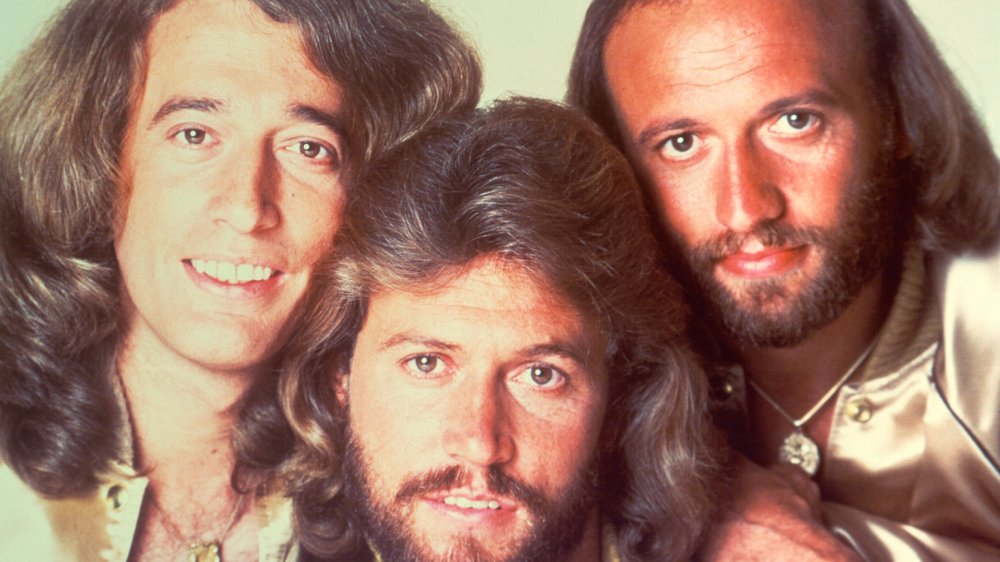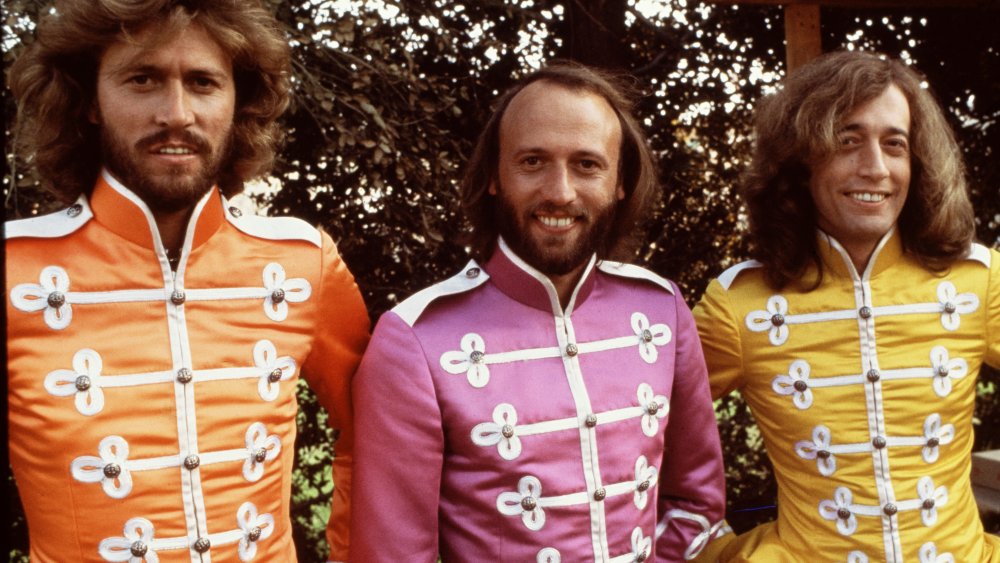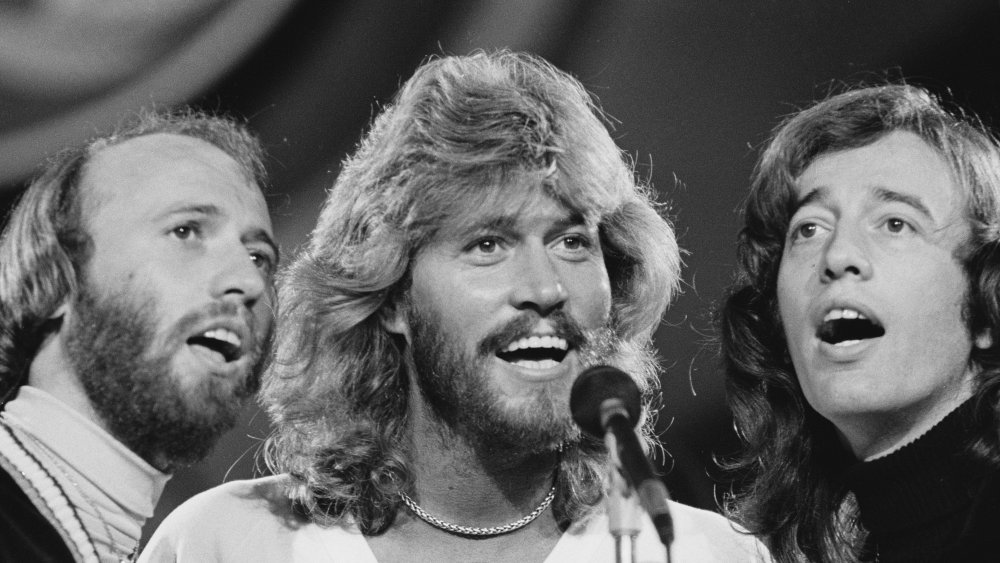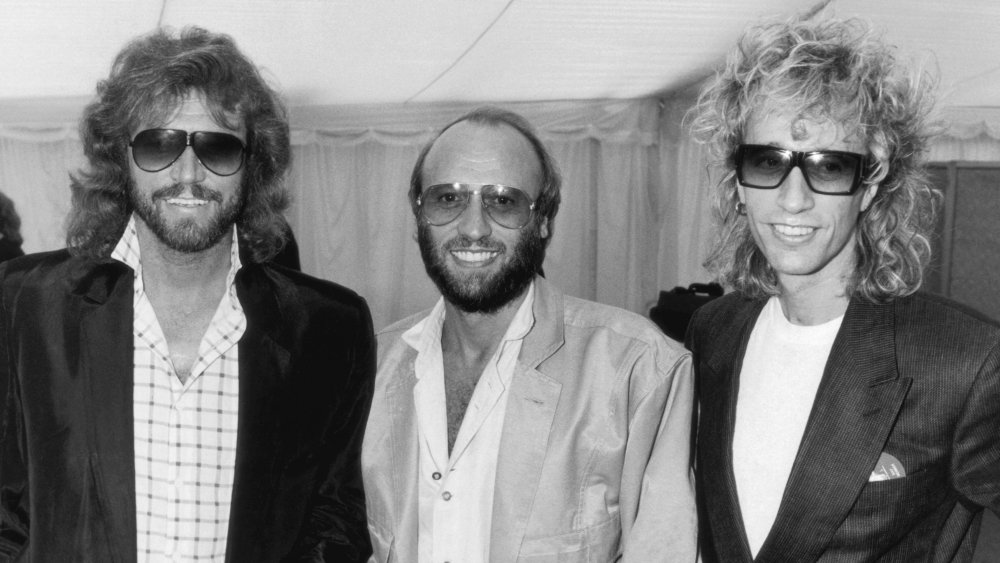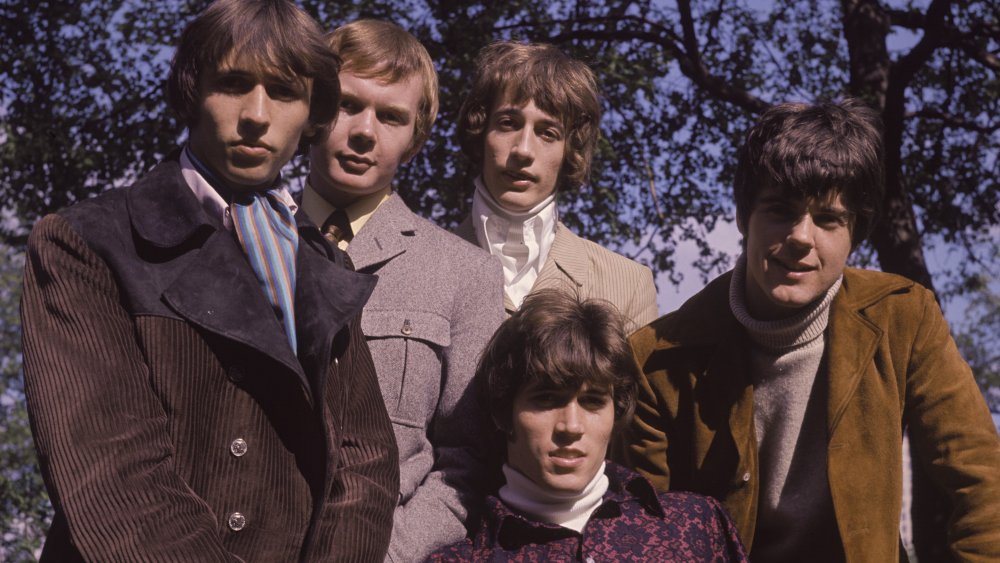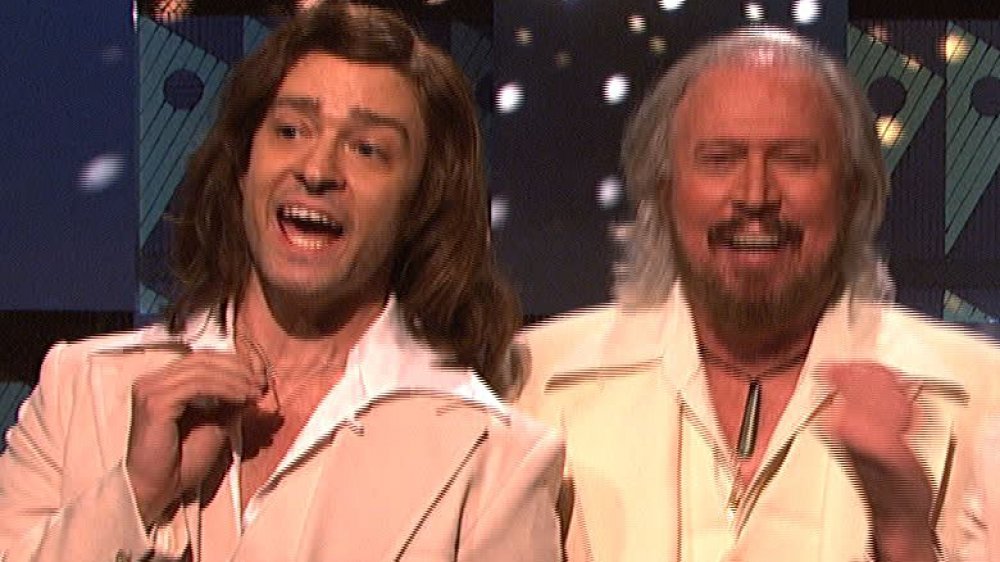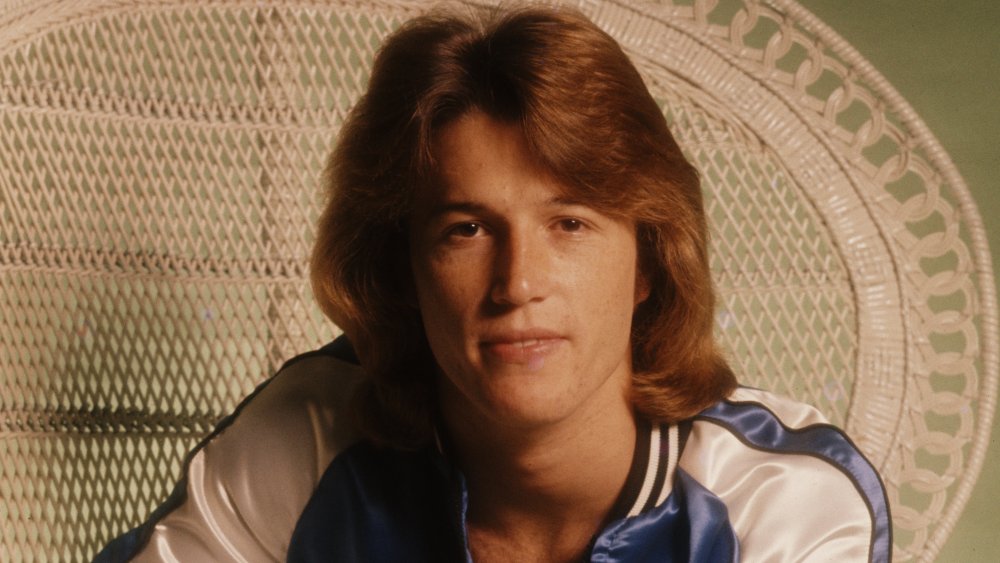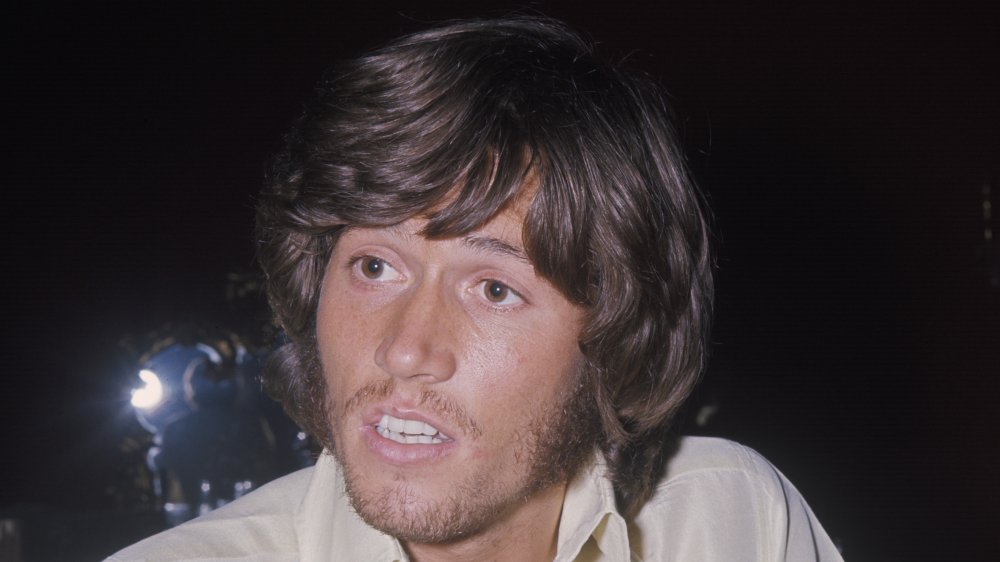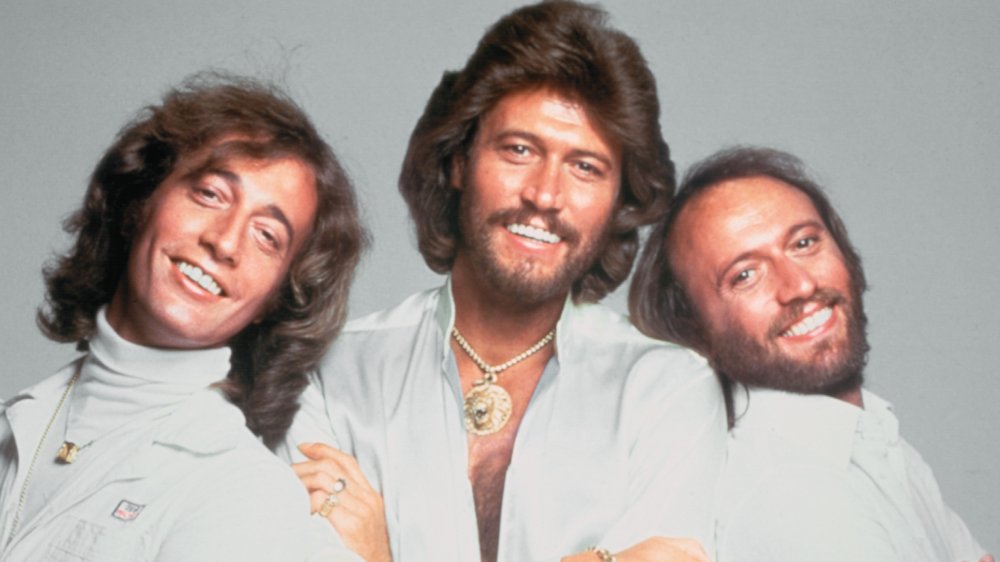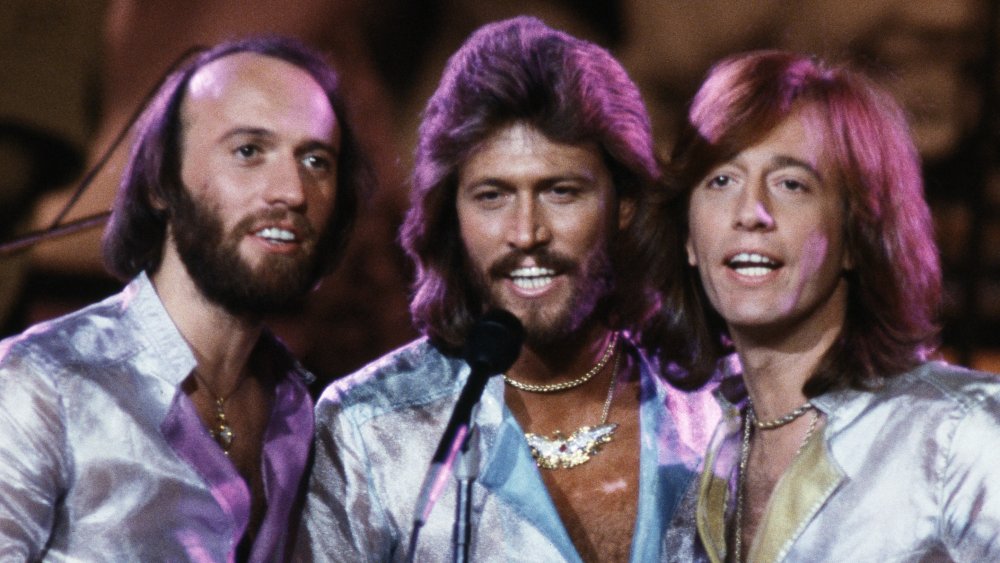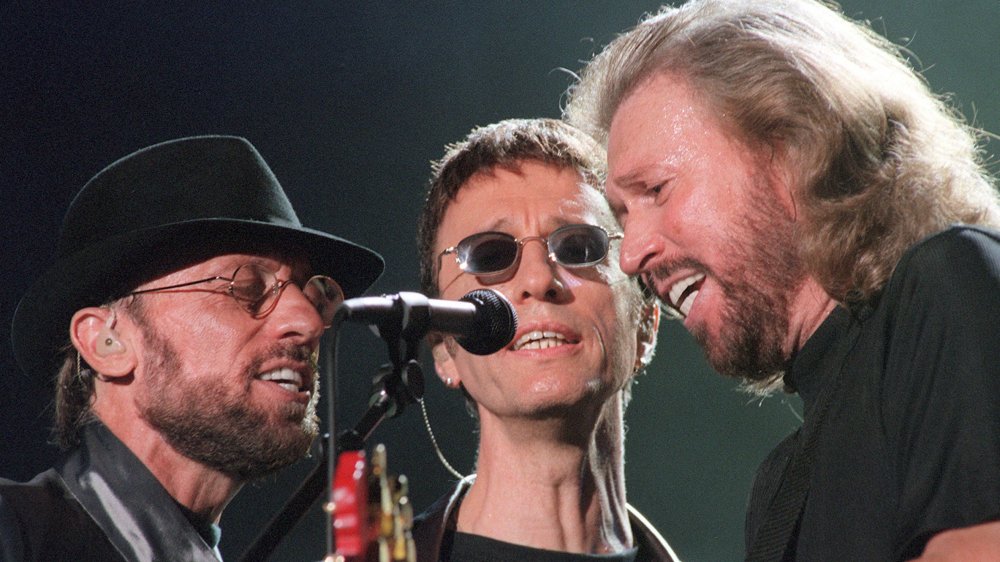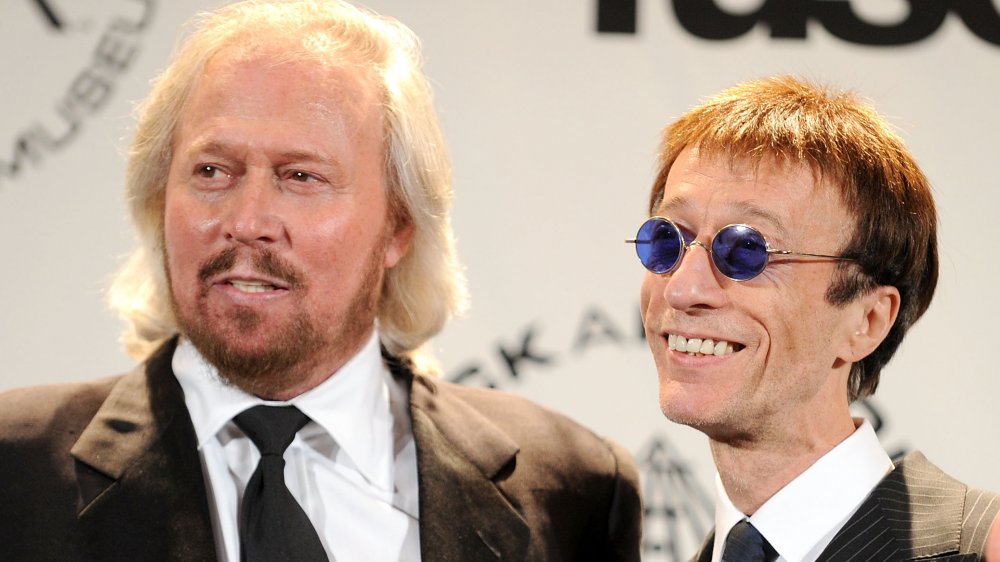False Things You Believe About The Bee Gees
It's no jive talk to say that the Bee Gees are one of the most extraordinarily successful musical acts of all time. How deep was fans' love for the group, who most notably consisted of brothers Barry Gibb, Robin Gibb, and Maurice Gibb? The Saturday Night Fever soundtrack stalwarts sold more than 120 million copies of their albums and scored more than two dozen top 30 hits on the Billboard pop chart, including No. 1 smashes "Stayin' Alive," "Too Much Heaven," "You Should Be Dancing," "Tragedy," and "Love You Inside Out." With the addition of their shiny stage costumes, soaring harmonies and signature falsetto vocals, and feathered hair, the Bee Gees defined an era of music — the disco craze of the late 1970s.
That meant that when the backlash to disco arrived, the Bee Gees became the butt of jokes and subject of derision. Subsequently, a lot of common knowledge about the Bee Gees spread, much of it based on half-truths or misinformation. Here's everything you actually know about the Bee Gees that just isn't true.
The Bee Gees were an Australian band
The Bee Gees are one of the biggest acts to ever emerge from Australia. Immensely popular around the world in the mid-20th century, Billboard rated them as a major and pioneering Australian act, alongside Olivia Newton-John and Rick Springfield. The Bee Gees scored nine No. 1 hits in the United States, for example, and another five chart-toppers in the United Kingdom, not far from the band's hometown.
Well that's confusing — how are the Bee Gees from Australia but also from the British isles? That's because the band called the Bee Gees formed and got its start in Australia after the three constituent Gibbs moved there as children. Barry, Robin, and Maurice Gibb all were born in the late 1940s in Douglas, the capital of the Isle of Man, a small island off of Great Britain. It's not a part of the United Kingdom, but as it is a crown dependency ceremonially ruled by Queen Elizabeth II, its residents are British citizens. In 1958, the Gibbs all moved to Sydney, Australia, and shortly thereafter, the three oldest children in the family formed a singing group.
The Bee Gees were a disco act
The Bee Gees enjoyed otherworldly global success as a disco act in the late 1970s, strongly associated with the sounds, look, and sensibility of the dance music phenomenon that enraptured the world for about five years. They populated and produced the soundtrack for one of the best-known disco movies, Saturday Night Fever, which sold a staggering 25 million copies between 1977 and 1980.
But disco was only one thing the Bee Gees could do, and in the waning part of the 1970s, it was simply their latest endeavor. The group already had a long, active, and healthy career as hitmakers by the time disco hit. In the mid-'60s, the Gibbs moved to London, hoping to cash in on the British rock craze of the era. Sounding less like the Beatles and more like a tightly harmonizing, more vocally accomplished, folk-influenced, gently psychedelic Herman's Hermits who sang long-titled story-songs and melancholic ballads, the Bee Gees scored a number of smashes in the late 1960s and early 1970s. In a word, the Bee Gees were weird, and yet it worked: "New York Mining Disaster 1941 (Have You Seen My Wife, Mr. Jones)," "I've Gotta Get a Message to You," "(The Lights Went Out in) Massachusetts," "To Love Somebody," and "I Started a Joke" were all big hits in America. The quiet and contemplative "How Can You Mend a Broken Heart" even hit No. 1. And none of these songs have a danceable beat or that bracing Bee Gees falsetto.
The Bee Gees didn't last into the 1980s
The Bee Gees caught disco fever, but they also never fully rejected other types of music. To the Gibbs' credit, they did adapt with the changing times, as if recognizing that the disco cash cow wouldn't last forever. Soft rock would prove very popular in the early 1980s, and the Bee Gees embraced it. After hitting No. 1 in 1979 with the ballad (and listen-at-work-radio staple) "Too Much Heaven," the group enjoyed some success in the immediate post-disco period, racking up minor and moderate hits like "He's a Liar," "Living Eyes," "The Woman in You," and "Someone Belonging to Someone."
So the public didn't hate the Bee Gees, it just wanted slightly less Bee Gees and less disco-centric Bee Gees, if at all possible. In 1980, Barry Gibb co-wrote (frequently with his brothers) and produced the whole of Barbra Streisand's contemporary pop breakthrough album, Guilty, and his work (including backing vocals) is so prominent that he's featured on the cover. The single "Woman in Love," an adult contemporary gem of a duet between Streisand and Gibb, went to No. 1. Also topping the charts, in 1983: "Islands in the Stream," the country classic by Kenny Rogers and Dolly Parton, written by the Gibbs.
The Bee Gees were a family band
The Bee Gees and "Gibb brothers" are used almost interchangeably, as if they mean the same thing. Most photos of the Bee Gees feature the three oldest sons, musically inclined members of the Gibb brood — Barry, and his associates in business and blood, twin brothers Robin and Maurice. And yes, from the band's disco era and into the next few decades, the Bee Gees did primarily produce, write, and record as a trio. But they did not go it alone. The band used collaborators and studio musicians to nail down its sound on stage and in the recording booth.
But those aren't official Bee Gees — one must go back to the group's days as a British Invasion-era pop-rock band and discover that the act was once a five-piece: the trio of Gibbs assisted by two bandmates to whom they were not related. On the Bee Gees' 1967 debut album 1st, the credited musicians are as such: Barry Gibb on rhythm guitar, Robin Gibb on organs, Maurice Gibb on various instruments including bass guitar... plus Vince Melouney on lead guitar and drummer Colin Petersen. That means at one point in history, a person could be a Bee Gee but not have to be a Gibb.
When disco died, the Bee Gees' hip factor diminished
The Bee Gees could have been a relic of the '70s, what with their airy songs about dancing played only on oldies radio stations that conjure up images of people frenetically dancing in their now silly looking haircuts and disco outfits to the stylings of the brothers Gibb. But the Bee Gees were bigger than all of that. Strip away the '70s production and studio tricks, and the atmosphere and circumstances of their original release, and one is left with some unassailable work. The Bee Gees made music that resonated with a lot of people, and it was held in high esteem by some of the world's most artistically significant arbiters of cool in the 1990s and beyond: rappers. How can the Bee Gees' music stay in the '70s if it was sampled all over the place decades later?
Jay-Z and Snoop Dogg both utilized elements of "Love You Inside Out," and "Stayin' Alive" is obviously central to both N-Trance's dance-rap hit "Stayin' Alive" and Wycleaf Jean's "We Trying to Stay Alive." (In the lyrics, Jean implores a DJ to "pump the Bee Gees.") Jean's fellow Fugee, Pras, then incorporated the Gibbs' "Islands in the Stream" into his 1998 smash, "Ghetto Superstar." DMX worked "Nights on Broadway" into his "The Convo," and the 1975 hit became the theme song of Saturday Night Live's "The Barry Gibb Talk Show," starring Jimmy Fallon and Justin Timberlake as Barry and Robin Gibb, respectively.
Andy Gibb was a Bee Gee
It's like the old saying goes: If it looks like a Bee Gee, sounds like a Bee Gee, and is inescapable on the radio in the 1970s, then it must be a Bee Gee. This assessment isn't exactly true, however, when it comes to Andy Gibb. The Bee Gees — which by the end of the 1970s consisted of Barry, Robin, and Maurice Gibb — had such a hold on pop music with their own soft rock-meets-disco sound that they expanded their reach, providing Bee Gees-esque hits for other acts, such as "Emotion," by Samantha Sang, "If I Can't Have You," by Yvonne Elliman, and the early works of Andy Gibb. He hit No. 1 with his first three singles in 1977 and 1978: "I Just Want to Be Your Everything," "(Love Is) Thicker Than Water," and "Shadow Dancing" — all with a writing credit from at least one other Gibb sibling.
Not yet 20 years old, Andy Gibb became one of the period's most prominent teen idols, what with how he sounded like those popular Bee Gees and also looked like one, only younger and blond. While he was a member of the Gibb family and performed songs written by the Gibb brothers, Andy was never a part of the Bee Gees — only a solo act up until his untimely death at age 30 in 1988.
The Bee Gees introduced falsetto to pop music
While they were many other things before, after, and during the world's brief infatuation with disco music in the late 1970s, the Bee Gees are rightfully remembered as the most disco of all disco acts, thanks to genre-iconic songs like "Stayin' Alive," "You Should Be Dancing," and "Night Fever." In those tunes and others, the band found a formula that worked: a relentless bass groove, plenty of brass and strings, and the ultra-high-pitched and powerful vocal stylings of lead singer Barry Gibb. He utilized a vocal technique (or trick) called falsetto, generally used by male singers to reach the upper register of the musical scale, which they wouldn't otherwise be able to hit naturally.
Gibb used falsetto so much that he's forever linked with it, even though many famous post-'70s singers have given it a shot, including The Weekend, Frank Ocean, Justin Timberlake, and Josh Homme. Gibb popularized falsetto for crossover pop and rock audiences, but he certainly didn't invent it. When the Bee Gees moved into its disco phase, the band didn't even call it by that name. "It certainly wasn't in our minds, and we certainly wouldn't have called it disco, we thought it was R&B," Gibb told Rolling Stone (via The Ultimate Biography of the Bee Gees). "We liked The Stylistics and the Delphonics and people who sang in falsetto." Gibb was merely imitating singers he admired.
The Bee Gees reinvented themselves as a disco act with Saturday Night Fever
Disco revitalized the fame and fortune of the Bee Gees, bringing the long-established group more success than it had ever seen before. But that new era for the Gibb brothers didn't begin with the soundtrack to Saturday Night Fever, the companion album to the blockbuster, Golden Globe-nominated 1977 John Travolta movie on which the Bee Gees contributed eight songs.
But it's not like Hollywood just gave the Bee Gees, a pop-rock group best known for its '60s and early '70s folky hits, free reign to make a smoldering disco soundtrack album for a movie about disco. The group's manager, Robert Stigwood, had agreed to finance and produce Saturday Night Fever. The Gibbs agreed to make a slew of songs for the movie, and its soundtrack, which went on to sell about 25 million copies. It was more of a favor to an old friend and associate than anything else, although the Bee Gees had already started to surf the disco wave. Saturday Night Fever wasn't released until late 1977 — the Bee Gees had already hit the top 10 in 1975 with disco tunes "Nights on Broadway" and "Jive Talkin.'"
They named themselves the Bee Gees because it meant Brothers Gibb
Perhaps simpler really is better, at least when it comes to band names. More than 50 years ago, Barry, Robin, and Maurice Gibb decided on what turned out to be the perfect name for their little band — an easy to remember, easy to pronounce, phonetically spelled out iteration of the letters "B" and "G." It's so immediately graspable that it can even surpass language barriers and grab potential fans who don't speak the Bee Gees' native English tongue. It's also so obvious a band name — clearly "Bee Gees" stands for "B.G.," which in turn represents "Brothers Gibb."
Amazingly that's not why they initially named themselves the Bee Gees — but it is a happy and uncanny coincidence. According to the Bee Gees' official website, the moniker was derived in part from the names of two other musicians with whom the Gibbs associated in their early days as a group. After moving to Australia in the late '50s, the teen and tween Gibbs got a gig playing live music on a radio station, alongside friends Bill Goode and Bill Gates (not the Microsoft founder and philanthropist). The band called itself The BG's, as three of its members had those initials — Goode, Gates, and Barry Gibb. After a while, The BG's expanded into Bee Gees, which is when the Brothers Gibb realized its secret meaning.
The Bee Gees never had a comeback
Were the Bee Gees has-beens, reduced to the dustbin of history after the end of disco sent them scampering out of the music industry, punished and gone forever for having dared align themselves with a faddish cultural moment? Not really, no. As the Bee Gees were rich, famous, and prolific musicians well before the dawn of disco, the group remained active entertainment industry titans until well past the death of disco, too.
The Bee Gees recorded throughout the 1980s and, in 1989, were driven to perform after the 1988 death of younger brother Andy Gibb. They landed in the top 10 for the first time in a decade with the ultra-slick, very '80s-sounding synth-pop head-bobber "One." It didn't lead to a lasting Bee Gees revival, but it did remind the world that those Gibb brothers sure could write a catchy song and then sing it well. History repeated itself eight years later when, in 1997, the Bee Gees, nearly two decades removed from disco by that point, enjoyed another comeback hit. The keyboard and synth-wind-driven mid-tempo ballad "Alone" hit No. 8 on the pop chart and became a smash on soft rock radio.
The Bee Gees split up
Breaking up a band is a complex ordeal. There's all the potentially traumatic emotional labor of once close friends and collaborators proclaiming they wish to no longer work together. Then they've got to hire lawyers and accountants to dissolve legal arrangements and determine who has rights to what band elements and if the royalty payment structure is fair. Regardless, bandmates can always walk away — that notion grows much more troublesome and less possible if the musicians are family.
The core of the Bee Gees has always been the three Gibb brothers. While all three tried out solo careers and worked with people to whom they weren't related, the Bee Gees never broke up. Any time the Bee Gees weren't making music together were simply breaks or slumps. The only thing that could and did sever the Gibbs' bond was death. Maurice Gibb passed away at age 53 in 2003, and surviving Bee Gees Barry and Robin Gibb played together sporadically thereafter, including at The Prince's Trust concert in London in 2006. The Bee Gees as an entity only truly ended in 2012, after the death of Robin Gibb, leaving Barry the only surviving member of the band.
